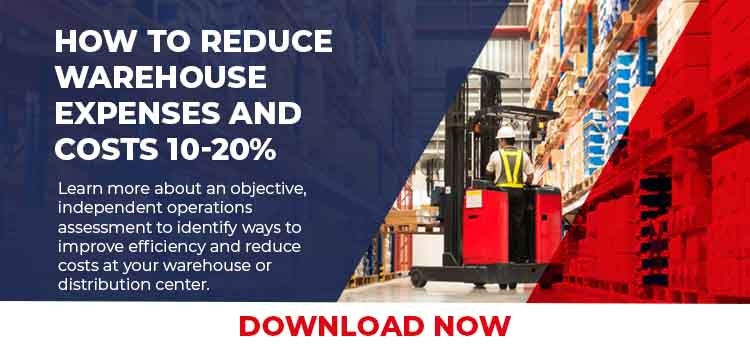As warehouse consultants, we work with a wide range of businesses, the discussions often surround topics such as, "How do we know if we are as efficient as we could be? What do we need to change to support the business’ growth and order fulfillment needs?” The short answer is typically companies need to perform a warehouse or distribution center operations assessment. 
So, what is an operations assessment? It is a methodical and comprehensive approach to analyzing all facets of the operations – from organizational staffing, team members and people utilization; processes, and warehouse management systems; to the layout of the facility; and how material handling equipment and automation are deployed. The objectives are to identify all the ways in which the warehouse operations and the physical assets can/should be improved to meet both the customer’s and management’s expectations and requirements. These recommendations should then be prioritized based on resources; capital expenditures required as well as benefits to build a roadmap for implementing the recommendations.
When Should a Warehouse Operations Assessment be Performed?
A warehouse assessment should be performed on a regular basis. Many companies do an assessment and implement changes at least once per year – some even after each season. Some of the drivers include:
- Storage and order throughput. When distribution centers are approaching maximum product storage capacity or throughput of customer orders, determine if there are solutions that can improve the facility usage and performance.
- Peak season processing. If the distribution center struggled with the previous peak season demand, identify ways to proactively improve the operations prior to the next peak seasonal volume.
- Product line changes. Additional product lines which dramatically vary from the current assortment (e.g., hard goods versus apparel, product conveyance, weight, etc.) can have a direct impact on the labor, material handling equipment, warehouse space or automation required.
- Facility growth plans. When an existing lease is in the final 12 to 18 months, determine if the existing facility is still the right building to support your supply chain strategy and future growth plans.
- Cost reduction. When the cost of order fulfillment and customer service has exceeded the budget, or become larger than anticipated.
These are just a few of the drivers that typically warrant an operations assessment. Also, think of an operations assessment as a proactive and preventative health check of the operations. Often, these are performed because fulfillment centers are struggling. However, operational assessments should be performed regularly to ensure that everything in the operations is running as best as it can.
This is the approach we take with clients, to always have a mindset of continuous process improvement. Operational environments, company services, and costs change. If a facility is left for long periods of time without being reassessed and revised, operations often use updated processes and do not find ways to reduce costs and improve service. Operations professionals should always be looking for ways to make both minor adjustments and major changes to continually meet or exceed the expectations of customers and management.
15 Tips for Performing a Warehouse Operations Assessment
Consider the following tips as you perform your operations assessment. These can easily add years of life back into your facility and operations. These are the major factors we review when performing an operational assessment when looking at warehouse performance:
- Product and order flow. Thoroughly understand the flow and utilization of the current layout, including rack configuration, slotting/pick philosophy, receiving, putaway, replenishment, inventory management, and packing and shipping. Include peak seasonal trends and thorough volume analysis of inbound and outbound product flow.
This should also include the full order return process.
- Facility utilization. Determine if you completely utilize the physical facility, including the full clear height of the facility. How does the physical footprint dictate or impede the flow of goods and people through the facility from receiving to shipping? How can you re-envision the processes and layout to work around these challenges? This is where our distribution center design consulting can help present different options.
- Storage and material handling solutions. Identify those racks and shelving units that do not maximize the full clear height. Are there opportunities to better utilize the vertical space with more appropriate racking or mezzanines? Do the stored goods
- Profile and slotting. During the operations assessment, evaluate the racking and shelving, and identify where the inventory doesn’t maximize the space in the bin locations. Are there opportunities for reprofiling and adding more locations to maximize the utilization of space?
- Better space use. Identify any potential work areas or staging space on the floor that prohibits good flow. Could these be relocated or moved to improve the space? As you review department functions, are there opportunities to increase or decrease space utilization? At the end of the day, some companies may need to consider the use of an offsite storage facility or warehouse space.
- Opportunities for product storage and conveyance improvement. Identify opportunities to move away from traditional racking or shelving. For instance, are there opportunities to utilize carton flow that could increase the picking efficiency while keeping pallet storage overhead? How could these changes improve the speed, warehouse efficiency, and inventory management for order fulfillment?
- Value-added services. In addition to pick, pack, and shipping orders, does the warehouse incorporate value-added processes such as repackaging or kitting? How well do these areas utilize the space? Are the workstations efficient? Is there a good flow of raw materials and finished goods?
- Vendor compliance. Consider inbound vendor compliance. Identify those vendors that create inbound receiving and storage challenges and add costs to operations. Determine what changes would have the greatest impact on the operations and warehouse efficiency. Work with the purchasing, and accounting to develop a comprehensive vendor compliance guide. Work with your vendors to meet these needs.
- Material handling equipment use. Consider the current and future needs for material handling equipment. (e/g/ forklifts, stock pickers, etc.). Are they the most efficient pieces of equipment to use? Are there changes to the layout and design that would dictate different lifts that are more efficient?
- Warehouse management systems. From a systems perspective, the same level of due diligence should be executed. Identify potential gaps and determine if the system can support the gaps, or what workarounds should be developed. If the gaps are too big, your company will need to decide if a potential system change out is needed.
- Size and use of the inbound receiving docks. Are you scheduling inbound receipts with dock times etc., to support your labor planning? Or do receipts arrive randomly and you have to pull labor away from other tasks to handle the unexpected receipt?
- Dock doors. Are the number of dock doors sufficient to handle the inbound and outbound volumes? If not, is there any opportunity to add additional dock doors to support the volume, or schedule tasks more efficiently to relieve congestion?
- Labor utilization. Picking and packing are major labor costs. Do you have pickers that have significant downtime that decreases the overall throughput? Are you bringing in your pickers and packers at the same time, but the packers are waiting on the initial picks to be completed before they have work? Determine the best way to maximize each labor hour by staggering some functions.
- Order packing. Do the packers have sufficient packing supplies for at least half a day’s processing? Can they efficiently resupply their pack stations during a break? Are they constantly leaving the pack station to deal with incorrect orders? How can you increase the efficiency of packing?
- Performance metrics and reporting. Do you apply performance metrics and manage a performance reporting program to make the most of your most valuable asset—the employees?
Once you have completed the operational assessment, determine how much change each potential improvement will require and what cost/benefit each can achieve. What low-hanging fruit is there? What changes will require capital or involvement of other departments (e.g., vendor compliance). From this list, determine the recommended process improvement list. What changes should be initiated immediately and completed within three to six months? What changes require further study, management approval or long lead times (e.g., equipment and automation). Implement a plan to continually initiate an operations assessment to stay on top of the changes.
In summary, the heart of continuous improvement is the operational assessment and committing to periodic updates identifying the tweaks and long-term changes that reduce costs and improve customer service.







SHARE